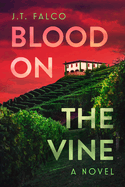
More than blood seeps into the soil of an elite Napa Valley winery in the outstanding Blood on the Vine. TV writer and showrunner J.T. Falco packs his first novel with murder, competitive businesses, family rivalry, greed, sex-cult rumors, controversial farming methods, and entitlement, but his smooth plotting and attention to fully realized characters ensure that this crime procedural doesn't seem overstuffed.
Lana Burrell has led a fairly isolated life for the past 22 years, ever since she fled her Napa home at age 17, when her father, Clifford, was convicted of murdering her best friend, Jessica Bancroft. Clifford, an artist, had designed bottle labels while managing the prestigious Golden Eagle Winery, owned by "Napa's First Family," the Bancrofts. Lana believes him innocent, but her prison visits to him have tapered. She is now a seasoned FBI agent in San Francisco's field office who avoids wine and Napa, preferring popcorn and beer, but reluctantly agrees to investigate the murders of two young women, who were both last seen at the Golden Eagle. Lana is surprised by the warm greeting she receives from Jessica's mother, Holly, and a somewhat civil meeting with the sheriff who arrested her father. Her investigation plunges her into a quagmire of business practices and family secrets as Lana reexamines her own choices. Her pairing with a chatty new 61-year-old deputy adds levity while allowing both women to shine.
Lana's cynical voice and perceptive insights, along with Falco's primer on viticulture, make Blood on the Vine an outstanding debut. --Oline H. Cogdill, freelance reviewer

